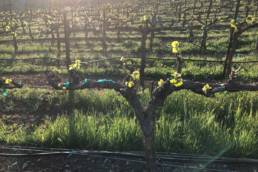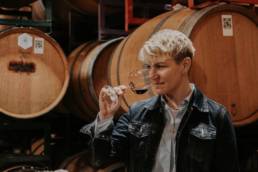FMN – August 2020 – Homeschooling and Hurricane Drinking
So we’ve braved over half of what has been an unprecedented year. Now with the pandemic continuing to cause turmoil, the serenity of our children starting school again has, at best, been delayed. To further fuel the fire, the dust storms have subsided and the hurricane season has ramped back up. All this leads to one common and foregone conclusion, we will be drinking.
The economic impact of our current milieu has affected everyone on some level but with the aforementioned circumstances, temperance is not an option. In these situations, I look for wines that are easy on the wallet but drinking above their respective price points.
I’ve been gravitating to Spanish wines lately due to their freshness, ability to go with a myriad of foods and, most times, reasonable pricing. Although there are great wines all over Spain, we are limited to what our regional distributers feel are “sellable” wines. That word sticks in my craw but nonetheless a topic for another conversation.
The Penedès wine area, thanks to its proximity to the tourist heavy Barcelona, has exploded with popularity and their wines have become more readily available. This Denominación de Origen (DO) is located within the geopolitical region of Cataluña, and unlike many of the other wine producing regions here, Penedès produces more white than red. This ancient region boasts being the birthplace of the traditional method sparkling wine, Cava and was the first in all of Spain to use temperature controlled stainless steel tanks for fermentation.
Although the reds of neighboring Priorat and Tarragona produce noteworthy reds, and one cannot neglect the diversity of sparkling wines produced here, Penedés continues represent some of the greatest value white wines in all of Spain. With the area focused on the export market, these wines are bound to be found on your local shelves.
I was called out lately about my opinionated views when it comes to Pinot Noirs. I’m guilty of liking a more earthy driven style and tolerate muted fruit constituents, even with a slight bit of Brett. I think there are quality Pinot Noir wines out there that are fruit driven, reasonably priced, varietally true and even domestically produced. I specify “varietally true” because I’ve had some technically well-made wines (Pinot Noir) that one would swear it was a Merlot. Sure, it can still be an enjoyable wine but it has lost its sense of grape identity and took on the identity of the winemaker’s Frankenstein.
I stumbled onto one of these domestic fruit driven Pinot Noirs lately and became inspired. Oddly enough, it wasn’t until after I researched the wine, I came to find these wines are made from sourced grapes buy the founders of Winc (formerly Club W).
Starting as a wine club, they quickly grew outside those confines to find themselves and winemaker Ryan Zotovich an overnight success as wine producers with thousands of online followers and subscribers. Their shtick now is determining what styles and types of wines their consumers want based on answering a series of questions about other foods and drinks they like. Although I am not a subscriber, I find the concept cool and interesting and, as evidenced by their success, apparently so do thousands of other wine consumers.
Although there are hundreds of under-appreciated and “value” wine producing areas all over the globe, many are unable to easily acquire. Luckily, the wines of South America have, mainly through the popularity of Argentine Malbec, increased in domestic availability.
The wines of Chile have especially benefitted but I hear little chatter from Sommeliers and distributors touting the quality and value of these underappreciated gems. Although that seems a sad state of affairs, for those of us that know about them, opportunity to drink these wallet-friendly wines abounds.
Chile, as a wine producing country, can be viewed as both “old world” and “new world”. Vines were brought here in the 16th Century for mainly sacramental wines and over the next few hundred years their wine industry has been up and down due to changing political climates. With the establishment of democracy in the 1980’s, and an influx of foreign investment and knowledge, Chile continues to evolve and redefine its wine indentity.
Most of the vines here exist on their original rootstock, a rarity in today’s vineyards due to the grape louse phylloxera’s prevalence. Chile, however, has the natural boundaries of Patagonia in the south, high altitude dessert in the north, the Andes to the east and ocean to the west that have kept this pest out of their vineyards. With the varying soils, altitudes and ocean influences, the full potential of these Chilean production regions has yet to be fully realized.
Whether you are stocking up for your hurricane supplies, celebrating schooling-from-home or simply have had enough of this year, remember some of these wines for your consideration. As they represent a value from three very different angles, I’m certain you will appreciate what they have to offer. Raise a glass to a better second half of the year.
Suggested Wines:
Avinyó Vi D’Agulla 2019 Penedés, Spain $16.99
The wine contains 80% Muscat Petit Grain and 20% Macabeu varieties. Vi d’agulla means “prickly wine” in Catalan and one first notices the obvious petillance (slow lazy bubbles). The overt nose boasts tropical fruit (banana), essence of a childhood favorite (circus peanuts), and citrus blossom. The dry palate has a bright up front acidity, a prickly mouthfeel, and a medium body. The flavors of ripe unctuous fruit (candied lime) and mineral (limestone) finishes with a mouth-drying, prickly tangerine citrus element. Pair this wine with marinated shrimp ceviche (pickled), raw on the half shell (clams or oysters) or by the pool in “Serengeti” hot weather.
Folly of the Beast 2018 Central Coast, CA $18.99
Grapes sourced from the Central Coast of California produce this fruit laden Pinot Noir. The medium ruby color emerges into aromas of raspberry, cranberry, brambles and baking spice (allspice and vanilla). The palate is dry with medium acidity, medium body, fine grained subdued tannins and flavors of cherry, raspberry, vanilla. Pair with BBQ chicken, bacon wrapped scallops, smoked sausage.
Siegel Special Reserve Carmenère 2018 Colchagua Valley, Chile $17.99
This remnant of the ancient Bordeaux blend finds a home in the confines of Chile. The inky color is classic to this variety and was used to provide some depth of color to blends. The nose has a sweet black fruit nuance (blackberry, plum), baking spice, green peppercorns with a certain savory aspect (soy sauce, meat). The dry palate has a viscous mouth-feel with firm tannins that seem to hit the back of the mouth then quickly mellow. The flavors of raspberry, plum, and baked pie spices continue to a tart fruit-skin finish. Pair with grilled pork, roast game birds and burgers.




